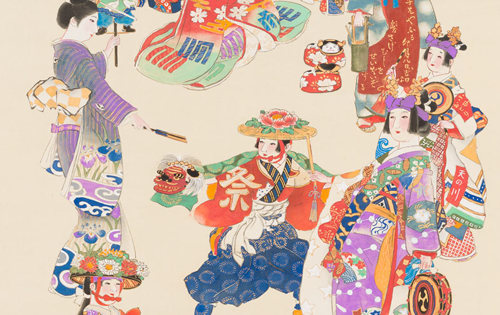- Events & Programs Home
- Calendar
- Accessibility
- Adults
-
Families & Teens
- Families & Teens Home
- 10x10 Teen Art Expo
- Art on the Rise
- Art Together: Art Making for Families with Children Ages 3–5
- Babies Sing with May Festival Minis
- Boy Scouts / Girl Scouts
- CAM Kids Day
- Family Storytime and Gallery Walk
- Family Studio: Art Making for Families with Children Ages 6–12
- Games in the Galleries
- Members-Only Baby Tours
- Public Baby Tours
- REC Reads
- Rosenthal Education Center (REC)
- Saturday Morning Art Class
- See Play Learn Kits
- Summer Camp
- Teen Fest: Zine and Comic Exchange
- RECreate
- Teachers
- Community Outreach
- Fundraisers
- Plan Your Own Event

- Events & Programs Home
- Calendar
- Accessibility
- Adults
-
Families & Teens
- Families & Teens Home
- 10x10 Teen Art Expo
- Art on the Rise
- Art Together: Art Making for Families with Children Ages 3–5
- Babies Sing with May Festival Minis
- Boy Scouts / Girl Scouts
- CAM Kids Day
- Family Storytime and Gallery Walk
- Family Studio: Art Making for Families with Children Ages 6–12
- Games in the Galleries
- Members-Only Baby Tours
- Public Baby Tours
- REC Reads
- Rosenthal Education Center (REC)
- Saturday Morning Art Class
- See Play Learn Kits
- Summer Camp
- Teen Fest: Zine and Comic Exchange
- RECreate
- Teachers
- Community Outreach
- Fundraisers
- Plan Your Own Event
Blog: CAM Uncovered
Blog: CAM Uncovered
- Home
- Plan Your Visit
- Art
-
Events & Programs
- Events & Programs Home
- Calendar
- Accessibility
- Adults
-
Families & Teens
- Families & Teens Home
- 10x10 Teen Art Expo
- Art on the Rise
- Art Together: Art Making for Families with Children Ages 3–5
- Babies Sing with May Festival Minis
- Boy Scouts / Girl Scouts
- CAM Kids Day
- Family Storytime and Gallery Walk
- Family Studio: Art Making for Families with Children Ages 6–12
- Games in the Galleries
- Members-Only Baby Tours
- Public Baby Tours
- REC Reads
- Rosenthal Education Center (REC)
- Saturday Morning Art Class
- See Play Learn Kits
- Summer Camp
- Teen Fest: Zine and Comic Exchange
- RECreate
- Teachers
- Community Outreach
- Fundraisers
- Plan Your Own Event
- Give & Join
- About
- Tickets
- Calendar
- Exhibitions
- Collections
- Blog
- Shop
Just In Time For Spring: Rare Utagawa Kōshū Hanging Scroll
by By Dr. Hou-mei Sung
3/29/2021
Utagawa Kōshū , 歌川珖舟 , Japanese Spring Festivals , East Asian Art , Hanging Scroll

Utagawa Kōshū 歌川珖舟 (active late 19th/early 20th century), Japan, Japanese Spring Festivals detail, late 19th/early 20th century, hanging scroll, ink and colors on silk, Gift from the collection of Howard and Caroline Porter, 2019.290
The Museum recently received a gift of four magnificent Japanese paintings from the former collection of Howard and Caroline Porter. One of them is Spring Festivals by Utagawa Kōshū. This painting depicts major Japanese spring festivals using colorful doll-like figures. Starting from the upper right a young couple dressed in formal Japanese costumes is walking into the festive scenes. Below them, a young mother with a baby on her back celebrates Buddha’s birthday (April 8th) by holding a small portable shrine hanging from a pole decorated with flowers on top and a white elephant below. Inside the shrine is an image of a miniature baby Buddha. This clearly refers to the ritual performed on Buddha’s birthday in temples by sprinkling the baby Buddha statue with amacha, tea made from hydrangea leaves. The statue is often accompanied by a carriage decorated with a white elephant. Reference to this specific festival is also made in the poem written in gold on the mother’s apron. The rest of the festivals and activities depicted here include: Hinamatsuri, or the doll festival (March 3rd), traditional folk dancing and music playing, a New Year’s Eve parade with Shoki (the demon queller), the lantern festival (January 15th), and mochi tsuki (rice cake-making ceremony).
The artist signed at the lower right corner: 八十二翁歌川珖舟作 (painted by Utagawa Kōshū at eighty-two). Biographical information of Utagawa Kōshū is scarce. Kōshū was mainly known as an ukiyo-e artist active from the 1880’s to the 1920’s. Here, Kōshū demonstrated his strong ukiyo-e training in the skillful combination of striking designs with brilliant colors. Very few of Kōshū’s works survive today, and most of them are prints. Thus, Spring Festivals is a rare and important masterpiece of his late years.

Utagawa Kōshū 歌川珖舟 (active late 19th/early 20th century), Japan, Japanese Spring Festivals, late 19th/early 20th century, hanging scroll, ink and colors on silk, Gift from the collection of Howard and Caroline Porter, 2019.290
Cincinnati, OH 45202
Toll Free: 1 (877) 472-4226
Museum Hours
Museum Shop
Terrace Café
Library
Cincinnati Art Museum is supported by the tens of thousands of people who give generously to the annual ArtsWave Campaign, the region's primary source for arts funding.

Free general admission to the Cincinnati Art Museum is made possible by a gift from the Rosenthal Family Foundation. Exhibition pricing may vary. Parking at the Cincinnati Art Museum is free.
Generous support for our extended Thursday hours is provided by Art Bridges Foundation’s Access for All program.

General operating support provided by:



